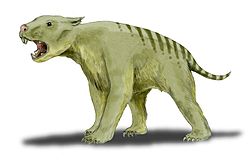| Wynyardiidae Temporal range: | |
|---|---|
| Scientific classification | |
| Kingdom: | Animalia |
| Phylum: | Chordata |
| Class: | Mammalia |
| Infraclass: | Marsupialia |
| Order: | Diprotodontia |
| Infraorder: | Vombatomorphia |
| Family: | † Wynyardiidae Osgood, 1921 [1] |
| Genera | |
| |
Wynyardiidae is an extinct family of possum-like marsupials from the early Miocene of Wynyard in Tasmania, long been considered to display skeletal features that are intermediate between the primitive polyprotodont and the advanced diprotodont marsupials.
Contents
Wynyardia's brain is clearly phalangeroid in external morphology, resembling closely that of the extant phalangerid Trichosurus vulpecula . This indicates that by 21 million years ago, an unambiguously phalangerid brain had evolved within the Diprotodonta family, indicating that both groups had a common ancestor prior to this date. Research on Wynyardia bassiana's relationship with fossil phalangerid species of the Miocene is an ongoing process.

